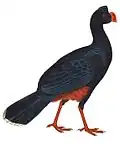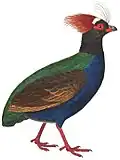Rustaviornis
| Rustaviornis Temporal range: Early Miocene
~ | |
|---|---|
| Scientific classification | |
| Kingdom: | Animalia |
| Phylum: | Chordata |
| Class: | Aves |
| Order: | Galliformes |
| Family: | Phasianidae |
| Genus: | † Burchak-Abramovich & Meladze, 1972 |
| Type species | |
| Rustaviornis georgicus Burchak-Abramovich & Meladze, 1972
| |
Rustaviornis is an extinct monotypic genus of pheasant-like bird. Its remains were discovered in Miocene-aged sediments near Rustavi, in Eastern Georgia.[1]
History and etymology
The genus Rustaviornis was erected in 1972 by Burchak-Abramovich and Meladze, based on a single distal fragment of a tibiotarsal bone, found in the right bank of the Kura, near the town of Rustavi, in modern Georgia, that was at the time a Union Republic of the USSR.[1]
The genus name, Rustaviornis, is formed by the prefix Rustavi-, referring to the town of Rustavi near which it was found, and the suffix -ornis, meaning "bird".[1]
Description
Rustaviornis is only known after a single and fragmentary holotype tibiotarsus, sharing similarities with those of modern-day pheasants and black grouse, although it was much larger, reaching the size of that of the modern junglefowl.[1]
Paleoecology
During the Early Miocene, the Iagluja locality, as well as several other sites in the area, was populated by a typical European Hipparion fauna, such as a Mediterranean tortoise, an undeterminate rodent, a badger, the skunk Promephitis, the hyenas Ictitherium and Adcrocuta, a saber-toothed cat, the early elephant Choerolophodon pentelicus, the namesake horse Hipparion cf. eldaricum, a chalicothere, the rhinoceros Dicerorhinus and Aceratherium, the hog Microstonyx, the deer Procapreolus, the giraffid Palaeotragus, and the bovids Oioceros, Paraoioceros and Tragocerus.[1]


